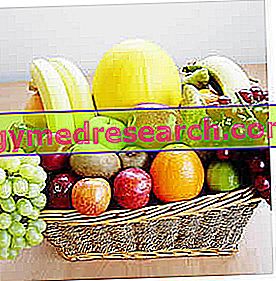Fruit
Fruit is a heterogeneous group of foods made up of different botanical species. As already extensively described in the article entitled "Fruit - fruit", this category includes many types of fruit, although some of them are commonly used as "side dish" vegetables or in savory preparations instead of sweets.
Without going into the subject again, let us remember that fruit can be differentiated according to two criteria;
- the first is true fruits and false fruits (the latter are wrapped in a fleshy receptacle originating from a part of the flower foreign to the pistil; the apples, pears and strawberries are examples of false fruits)
- the other: simple fruits, aggregates and infructescences.
Fresh fruit of the season

It goes without saying that the organoleptic and nutritional quality of the fruit depends both on the type of crop and the origin of origin, and on the storage time of the marketed product. The advice of food professionals is always oriented towards the consumption of local products (possibly with a short chain), seasonal products (therefore naturally developed) and not stored for long periods in cold storage.
The choice of a local product with a short chain guarantees:
- The financing of companies located on their own territory
- The elimination of intermediaries and the consequent moderation of the price for the benefit of both the producer (who can earn more but just enough) and the consumer (who saves)
- The right point of maturation; on the contrary, when the commercial path gets longer, the producer is obliged to anticipate the harvest of the fruit which is still unripe and therefore incomplete. NB the post-harvest maturation is similar but NOT the same as the natural one
- The freshness of fruit, as producers do NOT use conservative technologies
- The healthiness of the fruit, as a cultured and sold product does not allow micro-organisms to grow and does not require a long-term chemical antifungal intervention
- The organoleptic and nutritional quality as a consequence of point 5
In any case, if short supply chains are lacking, it is always advisable to purchase a national product; we recall that Italy boasts a series of rigorous production disciplines focused on consumer protection, while the same cannot be said with regard to fruits produced in non-EU territories.
At the same time, the choice of seasonal fruit guarantees a more advantageous quality / price ratio in all respects. Moreover, beyond the gustative and aromatic characteristics, also the nutritional quality (vitamins and antioxidants) draws a discreet advantage. The fruit is a "living" appendage of the plant, which benefits in particular from the presence of ultraviolet sun rays; therefore, greenhouse crops do not have the same metabolic intensity as a natural crop, and this is to the disadvantage of the nutritional composition of the crop.
Furthermore, it is always SCONSIGLIABILE to abuse tropical fruit; this is sustainable for two fundamental reasons:
- As anticipated, some climatic zones are characterized by an economic development inferior to ours, therefore, the cultural level STILL does not allow to orient the disciplinary of cultivation on the full protection of the final consumer (much less if the productive target is the export). The use of pesticides and pesticides is exponentially greater than in Italy.
- Much of the tropical fruit sold in Italy is very caloric: bananas, coconut, avocado, etc.
The fruit seasons
Below are listed different types of NATIONAL fruit in relation to the months of agricultural production:
- Winter ; late December-January-February and almost all of March : oranges, kiwi, lemons, pine nuts, mandarins, apples, pears.
- Spring ; late March - April - May - early June : kiwi, lemons, mandarins, apples, pears, loquats.
- Summer ; June-July-August-early September : apricots, watermelons, cherries, strawberries, figs, prickly pears, hazelnuts, almonds, pistachios, raspberries, lemons, apples, melons, blueberries, blackberries, medlars, pears, peaches, plums, currants, plums, grapes.
- Autumn ; September-October, November-early December : oranges, persimmons, hazelnuts, pistachios, pine nuts, chestnuts, walnuts, pomegranates, kiwi, lemons, mandarins, apples, pears, grapes.
NB . Not all the aforementioned varieties present on the market are of Italian origin, indeed, in reality the autochthonous ones are few. However, their seasonal location is still true because they represent botanical types widely cultivated on the national territory.
It is also appropriate to specify that the seasonality of the products always includes a minimum of conservation. It is not yet possible to guarantee the collective availability of fruit based solely on the short supply chain; today it is possible to preserve products such as apples, pears and kiwis for a few months, benefiting the trade even in late winter. We remind you that this is a much more advantageous technique than the traditional dehydration, candying, canned or under alcohol.
NB . The mention of jellies, jams and marmalades is voluntarily omitted and in my opinion they are too detached (in shape and content) from the fruit of origin.
Dehydrated / dried fruit
Dehydration is a method of preserving fruit that uses free water reduction. Dried fruits are typically: figs, dates, plums, grapes, apricots etc; they have no specific peculiarities and only a greater concentration of energy and nutrition (increase in calories per 100g of edible portion) due to dehydration are observed; however, I strongly advise everyone to investigate the relative method of water extraction. It can in fact take place through different procedures but, among these, one is certainly to be avoided: it is the extraction through the use of sulphates (if in excess, potentially harmful).
Candied fruit
Candying is also a method of preservation; it is based on the increase in sugar in the food (up to 70%) in order to inhibit microbial action. The candying is carried out by dipping the fresh fruit into pieces inside a hyperosmotic syrup in which the micronutrients are almost completely dispersed. Given the hypercaloricity and vitamin poverty, the food consumption of candied fruit is almost useless.
Fruit in a jar
The fruit in a jar is canned or dipped in alcohol; like candying and drying, these are also preservation methods. The syrup requires the cooking of fruit, which almost completely destroys the content of thermolabile vitamins (such as vitamin C); moreover, the preservation syrup is a liquid with a very high sugar content that makes the product high-calorie and not recommended (like candied fruit) in frequent or systematic use. Immersion in alcohol or "in spirit" instead, exploits the conservative potential of the alcohol itself. This is a method that is almost obsolete today and absolutely not recommended for feeding children. Also in this technique the fresh fruit must be previously cooked, therefore, the vitamin content suffers the same fate as that present in the fruit in syrup.



